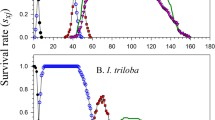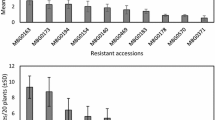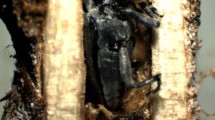Abstract
Sweetpotato weevil (SPW), Cylas formicarius elegantulus (Summers), is the most damaging root-feeding insect of sweetpotato, Ipomoea batatas (L.) Poir., worldwide. Larval feeding on storage roots reduces yield and induces terpene production, rendering roots inedible. Selection of sweetpotato cultivars with resistance to insect pests has been carried out for over a century but no high yielding, production acceptable varieties are currently available that are resistant to SPW. A cultivar with resistance to SPW oviposition would be a desirable choice for growers since it will reduce the number of larvae and damage level from SPW. Previous studies have compared cultivar effect on the oviposition of SPW but have not considered the effect of previous rearing experience. Hopkins’ host-selection principle (Hopkin’s HSP) states that phytophagous insects have an oviposition preference for the host that they have been reared on. In this study, we tested cultivar effect on oviposition preference of SPW reared on different cultivars for a minimum of two generations. For adults reared on cvs. Beauregard and Evangeline, adult oviposition preference followed their previous living experience. Thus, our results indicate a strong effect of host fidelity, supporting Hopkin’s HSP. Our results also confirm that cv. Murasaki is a resistant cultivar, resulting in reduced oviposition but not oviposition capacity. It is possible that the reduced oviposition is due to the stress-triggered oosorption from the females feeding on cv. Murasaki.





Similar content being viewed by others
References
Akhtar Y, Isman MB (2003) Larval exposure to oviposition deterrents alters subsequent oviposition behavior in generalist, Trichoplusia ni and specialist, Plutella xylostella moths. J Chem Ecol 29(8):1853–1870
Alabama Department of Agriculture and Industries (2007) Sweet potato weevil quarantine. Plant Industry Administrative Code, Chapter 80-10-5. http://www.alabamaadministrativecode.state.al.us/docs/agr/McWord10AGR5.pdf. Accessed 15 May 2018
Anderson P, Hilker M, Löfqvist J (1995) Larval diet influence on oviposition behaviour in Spodoptera littoralis. Entomol Exp Appl 74(1):71–82
Anyanga MO, Muyinza H, Talwana H, Hall DR, Farman DI, Ssemakula GN, Mwanga RO et al (2013) Resistance to the weevils Cylas puncticollis and Cylas brunneus conferred by sweetpotato root surface compounds. J Agric Food Chem 61(34):8141–8147
Barron AB (2001) The life and death of Hopkins’ host-selection principle. J Insect Behav 14(6):725–737
Bell WJ, Bohm MK (1975) Oosorption in insects. Biol Rev 50(4):373–396
Bernays EA (1993) Aversion learning and feeding. In: Papaj DR et al (eds) Insect learning. Springer, Boston, pp 1–17
Bohac JR, Jackson DM, Mueller JD, Dukes PD (2002) ‘Ruddy’: a multiple-pest-resistant sweetpotato. HortScience 37(6):993–994
Collier TR (1995) Host feeding, egg maturation, resorption, and longevity in the parasitoid Aphytis melinus (Hymenoptera: Aphelinidae). Ann Entomol Soc Am 88(2):206–214
Corbet SA (1985) Insect chemosensory responses: a chemical legacy hypothesis. Ecol Entomol 10(2):143–153
Coyle DR, Clark KE, Raffa KF, Johnson SN (2011) Prior host feeding experience influences ovipositional but not feeding preference in a polyphagous insect herbivore. Entomol Exp Appl 138(2):137–145
Dethier VG (1980) Food-aversion learning in two polyphagous caterpillars, Diacrisia virginica and Estigmene congrua. Physiol Entomol 5(4):321–325
Dukes PD, Hamilton MG, Jones A, Schalk JM (1987) ‘Sumor’, a multi-use sweet potato. HortScience 22(1):170–171
Edwards RL (1954) The effect of diet on egg maturation and resorption in Mormoniella vitripennis (Hymenoptera, Pleromalidae). Q J Microsc Sci 95:459–468
FAO (2013) http://www.fao.org/faostat/en/#data/QC. Accessed Feb 2017
Hahn SK, Leuschner K (1981) Resistance of sweet potato cultivars to African sweet potato weevil. Crop Sci 21(4):499–503
Harrison HF, Peterson JK, Snook ME, Bohac JR, Jackson DM (2003) Quantity and potential biological activity of caffeic acid in sweet potato [Ipomoea batatas (L.) Lam.] storage root periderm. J Agric Food Chem 51(10):2943–2948
Harrison HF, Mitchell TR, Peterson JK, Wechter WP, Majetich GF, Snook ME (2008) Contents of caffeoylquinic acid compounds in the storage roots of sixteen sweetpotato genotypes and their potential biological activity. J Am Soc Hortic Sci 133(4):492–500
Hopkins AD (1917) A discussion of CG Hewitt’s paper on insect behaviour. J Econ Entomol 10:92–93
Immelmann K (1975) Ecological significance of imprinting and early learning. Annu Rev Ecol Evol Syst 6(1):15–37
Jackson DM (2009) Evaluation of regional sweet potato genotypes for resistance to soil insect pests. Arthropod Manage Tests 34:M5
Jackson D (2010) Evaluation of regional sweet potato genotypes for resistance to soil insect pests. Arthropod Manage Tests 35(1):M7
Jackson DM, Bohac JR (2006) Survival and growth of Diabrotica balteata larvae on insect-resistant sweetpotato genotypes. J Agric Urban Entomol 23(2):77–86
Jackson DM, Harrison HF Jr (2013) Insect resistance in traditional and heirloom sweetpotato varieties. J Econ Entomol 106(3):1456–1462
Jackson DM, Peterson JK (2000) Sublethal effects of resin glycosides from the periderm of sweetpotato storage roots on Plutella xylostella (Lepidoptera: Plutellidae). J Econ Entomol 93(2):388–393
Jackson DM, Bohac JR, Thies JA, Harrison HF (2010) ‘Charleston Scarlet’ sweetpotato. HortScience 45(2):306–309
Jackson DM, Harrison HF, Ryan-Bohac JR (2012) Insect resistance in sweetpotato plant introduction accessions. J Econ Entomol 105(2):651–658
Janz N, Söderlind L, Nylin S (2009) No effect of larval experience on adult host preferences in Polygonia c-album (Lepidoptera: Nymphalidae): on the persistence of Hopkins’ host selection principle. Ecol Entomol 34(1):50–57
Jones A, Dukes PD, Schalk JM, Hamilton MG, Mullen MA, Baumgardner RA et al (1983) ‘Resisto’ sweet potato. HortScience 18(2):251–252
Jones A, Dukes PD, Schalk JM, Hamilton MG, Mullen MA, Baumgardner RA et al (1985) ‘Regal’ sweet potato. HortScience 20(4):781–782
Kays SJ (1992) The chemical composition of the sweetpotato. In: Hill WA, Loretan PA (eds) Sweetpotato technology for the 21st century Tuskegee. Tuskegee University, Tuskegee, pp 201–262
Korada RR, Naskar SK, Palaniswami MS, Ray RC (2010) Management of sweetpotato weevil [Cylas formicarius (Fab.)]: an overview. J Root Crops 36:14–26
LaBonte DR, Villordon AQ, Clark CA, Wilson PW, Stoddard CS (2008) ‘Murasaki-29’ sweetpotato. HortScience 43(6):1895–1896
Mao L, Story RN, Hammond AM, LaBonte DR (2001) Effect of sweetpotato genotype, storage time and production site on feeding and oviposition behavior of the sweetpotato weevil, Cylas formicarius (Coleoptera: Apoinidae). Fla Entomol 84:259–264
Marti HR, Mills HA, Severson RF, Kays SJ (1993) Variation in the concentration of surface terpenoids in storage roots of centennial sweetpotato. J Plant Nutr 16(5):741–752
Minkenberg OP, Tatar M, Rosenheim JA (1992) Egg load as a major source of variability in insect foraging and oviposition behavior. Oikos 65:134–142
Mullen MA, Jones A, Paterson DR, Boswell TE (1985) Resistance in sweet potatoes to the sweetpotato weevil, Cylas formicarius elegantulus (Summers) 1. J Entomol Sci 20(3):345–350
O’Brien PJ (1972) The sweet potato: its origin and dispersal. Am Anthropol 74:342–365
Peterson JK, Jackson DM (1998) Influence of sweetpotato resin glycosides on the life cycle of the diamondback moth. HortScience 33(4):606
Phillips WM (1977) Modification of feeding ‘preference’ in the flea-beetle, Haltica lythri (Coleoptera, Chrysomelidae). Entomol Exp Appl 21(1):71–80
Reames E, Smith T (2015) Louisiana sweet potatoes ‘Louisiana yams’. Louisiana State University Agricultural Center, Publication No. 1843
Rietdorf K, Steidle JL (2002) Was Hopkins right? Influence of larval and early adult experience on the olfactory response in the granary weevil Sitophilus granarius (Coleoptera, Curculionidae). Physiol Entomol 27(3):223–227
Rosenheim JA, Heimpel GE, Mangel M (2000) Egg maturation, egg resorption and the costliness of transient egg limitation in insects. Proc R Soc Lond [Biol] 267(1452):1565–1573
Roush RT, McKenzie JA (1987) Ecological genetics of insecticide and acaricide resistance. Ann Rev Entomol 32(1):361–380
SAS Institute Inc (2013) SAS® 9.4 Guide to Software Updates. SAS Institute Inc, Cary
Smith CM (2005) Plant resistance to arthropods: molecular and conventional approaches. Springer, Dordrecht
Smith T, Beuzelin J (2015) Insect pest management in Louisiana sweet potatoes. Louisiana State University Agricultural Center. Publication No. 2620
Smith TP, Hammond AM (2006) Comparative susceptibility of sweetpotato weevil (Coleoptera: Brentidae) to selected insecticides. J Econ Entomol 99(6):2024–2029
Smith T, Villordon A, Sheffield RE, LeBlanc BD, Nix K (2012) Environmental best management practices for sweet potato cultivation. Louisiana State University Agricultural Center. Publication No. 2832
Son KC, Severson RF, Kays SJ (1991) A rapid method for screening sweetpotato genotypes for oviposition stimulants to the sweetpotato weevil. HortScience 26(4):409–410
Stange RR, Midland SL, Holmes GJ, Sims JJ, Mayer RT (2001) Constituents from the periderm and outer cortex of Ipomoea batatas with antifungal activity against Rhizopus stolonifer. Postharvest Biol Technol 23(2):85–92
Stevenson PC, Muyinza H, Hall DR, Porter EA, Farman DI, Talwana H et al (2009) Chemical basis for resistance in sweetpotato Ipomoea batatas to the sweetpotato weevil Cylas puncticollis. Pure Appl Chem 81(1):141–151
Story RN, Hammond AM, Murray MJ (2000) Evaluation of sweetpotato germplasm for resistance to sweetpotato weevil, 1999. Arthropod Manage Tests 25(1):M20
Talekar NS (1991) Integrated control of Cylas formicarius. In: Jansson RK, Raman KV (eds) Sweet potato pest management: a global perspective. Westview Press, Boulder, pp 139–156
Technau G, Heisenberg M (1982) Neural reorganisation during metamorphosis of the corpora pendunculata in Drosophila melanogaster. Nature 295:405–407
Truman JW (1990) Metamorphosis of the central nervous system of Drosophila. J Neurobiol 21(7):1072–1084
Tully T, Cambiazo V, Kruse L (1994) Memory through metamorphosis in normal and mutant Drosophila. J Neurosci 14(1):68–74
Uritani I, Saito T, Honda H (1975) Induction of furano-terpenoids in sweet potato roots by the larval components of the sweet potato weevils. Agric Biol Chem 39(9):1857–1862
Van Alphen JJ, Visser ME (1990) Superparasitism as an adaptive strategy for insect parasitoids. Ann Rev Entomol 35(1):59–79
Van Emden HF (1999) Transgenic host plant resistance to insects—some reservations. Ann Entomol Soc Am 92(6):788–797
Van Emden H, Sponagl B, Wagner E, Baker T, Ganguly S, Douloumpaka S (1996) Hopkins’‘host selection principle’, another nail in its coffin. Physiol Entomol 21(4):325–328
Acknowledgements
We thank the Sweetpotato Research Station researchers and staff for their generous support in this study. This study was partially funded by the Louisiana Sweet Potato Commission and the Louisiana State University Agricultural Center. This article was approved for publication by the Director of the Louisiana Agricultural Experiment Station as manuscript No. 2018-234-32151.
Author information
Authors and Affiliations
Corresponding author
Ethics declarations
Conflict of interest
The authors declare that they have no conflict of interest.
Additional information
Handling Editor: Rupesh Kariyat.
Publisher's Note
Springer Nature remains neutral with regard to jurisdictional claims in published maps and institutional affiliations.
Rights and permissions
About this article
Cite this article
Chen, J., Stout, M.J., Beuzelin, J. et al. Host preference of sweetpotato weevil, Cylas formicarius elegantulus (Summers): an example of Hopkins’ host-selection principle. Arthropod-Plant Interactions 13, 779–786 (2019). https://doi.org/10.1007/s11829-019-09704-0
Received:
Accepted:
Published:
Issue Date:
DOI: https://doi.org/10.1007/s11829-019-09704-0




